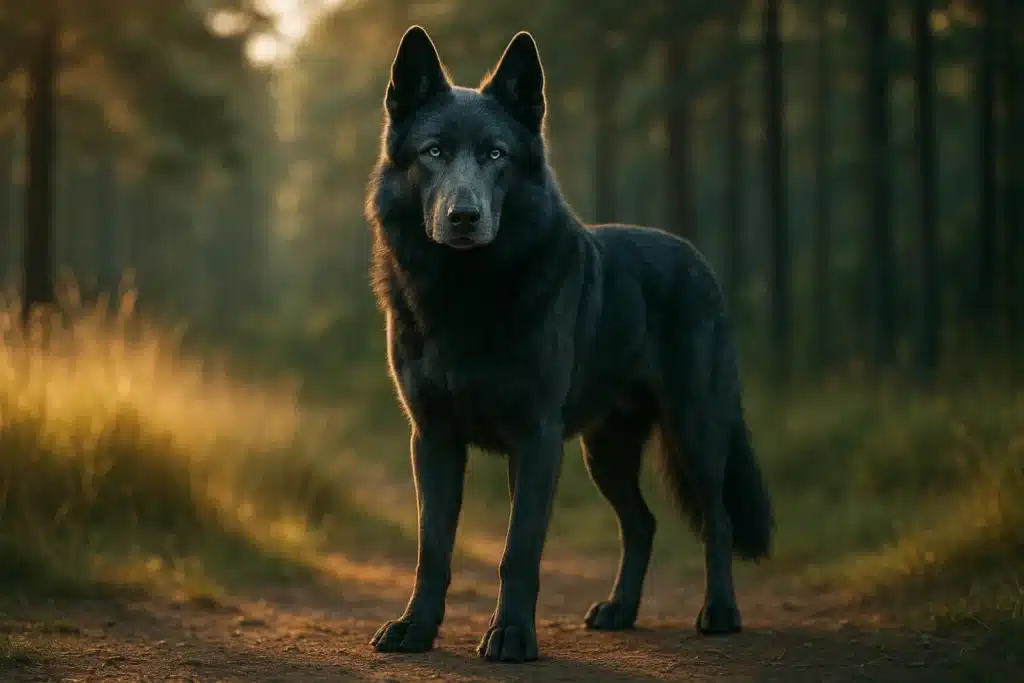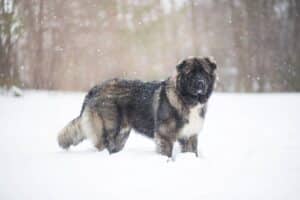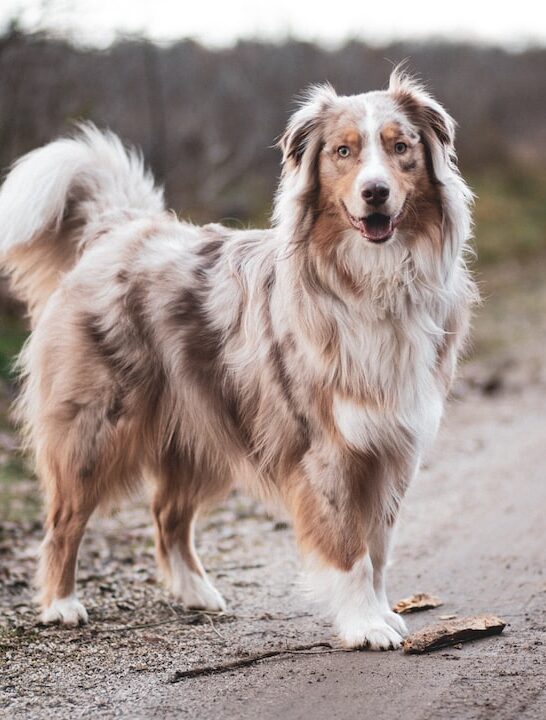Blue Bay Shepherd Puppy
What Is a Blue Bay Shepherd Puppy?
A Blue Bay Shepherd puppy is a special mix of dog breeds, created to look like a wolf but act like a friendly, trainable pet. These dogs were first developed by Vicki Spencer at Southern Breeze Ranch in Palm Bay, Florida, beginning in the 1990s. The idea was to make a wolf-like dog with the kindness and loyalty found in German Shepherds.
Genuine Blue Bay Shepherds only come from Spencer’s breeding program. If someone else claims to sell Blue Bay Shepherds, it’s likely not real. The breed is still being improved after more than 20 years, with Spencer always working on getting the breed’s features just right.

Origin and Breed Development
The Blue Bay Shepherd is the result of over 30 years of Vicki Spencer’s work with wolfdogs. At Southern Breeze Ranch, her goal was to combine the wild look of a wolf with the calm personality of a companion dog. She crossed blue European German Shepherds with Wolfdogs (these Wolfdogs were part Siberian Husky, Alaskan Malamute, and Eastern Timber Wolf) that had a small amount of actual wolf in them. Spencer chose European German Shepherds because American types often have joint and back health problems.
The aim was to keep the wolf content around 6% for beauty without wild behavior. By focusing on blue-coated German Shepherds and Eastern Timber Wolves, she wanted the pups to have a rich blue color, which became the breed’s signature look. The first litter was born over twenty years ago, and improvements continue every generation.
Why Are They Called Blue Bay Shepherds?
The breed’s name comes from two things: their blue fur and their place of origin. The “Blue” refers to their deep blue-gray coat, a result of careful breeding with blue German Shepherds and blue Eastern Timber Wolves. “Bay” stands for Palm Bay, Florida, Vicki Spencer’s hometown and where the breed was started. Only Southern Breeze Ranch produces true Blue Bay Shepherds.
Physical Traits of Blue Bay Shepherd Puppies
Blue Bay Shepherd puppies grow into large, athletic dogs that mix the features of German Shepherds and wolfdogs. Their bodies are sleek and strong, with a look that’s meant to remind you of a wolf. These dogs are active and fit well with people who enjoy the outdoors.
Males are bigger than females. Grown females usually stand 24-28 inches tall and weigh 70-85 pounds, sometimes up to 100 pounds. Males are larger, standing 26-30 inches and weighing 85-105 pounds, with some reaching up to 130 pounds. Their large size, broad heads, strong jaws, and upright ears give them a true wolf-like look.
Coat Texture and Color
The coat is thick, double-layered, and soft, offering good warmth and protection in cold weather. Their fur is most commonly a blue-gray color, but you might also see variations like dusted, brownish-black, red, or white.
Some Blue Bay Shepherds may get lighter fur as they age, a change called “phasing.” This happens in wolves, too – a dark gray coat may slowly turn gray or white over years, especially if the wolf content is higher. This makes each dog’s look even more unique.
Size and Growth Rate
| Sex | Height | Weight |
|---|---|---|
| Females | 24-28 inches | 70-85 lbs (up to 100 lbs) |
| Males | 26-30 inches | 85-105 lbs (up to 130 lbs) |
Puppies grow quickly, so owners should expect to see their dogs get big in a short time. Their size is one of the things that makes them stand out, and new owners should make sure they have enough space at home for a large, active dog.
Distinctive Features
- Eyes: Usually almond-shaped and light in color (amber, gold, or light brown), giving a sharp and smart expression.
- Head: Wide, slightly angled, with a strong jaw, looking much like a wolf.
- Ears: Upright and pointed, adding to their wolf-like profile.
- Build: Athletic and slightly longer bodies for a powerful, agile look.
The combination of these features gives Blue Bay Shepherds their wild, yet approachable beauty.

Temperament and Puppy Behavior
Blue Bay Shepherd puppies are bred to be friendly and easygoing, even though they look like wolves. Spencer wanted to keep their behavior gentle and safe for families, removing any aggression from the German Shepherd side. As a result, these puppies are loving, calm, and playful.
They are bred mainly as companions, not work dogs. While they can be cautious or shy with new people, they become affectionate and social once comfortable. Early socialization is needed so they grow up confident and well-behaved.
General Nature and Personality
Blue Bay Shepherds are known for being gentle, friendly, and smart. Puppies are playful and love to spend time with their families, enjoying games and attention. They are loyal and easily form close bonds with the people they know.
They also notice and react to human emotions, often acting as comforting companions. While they sometimes show shyness at first, their loving nature quickly comes through as they settle in with people.
Socialization Needs
Because they have some wolfdog background, it’s important to introduce Blue Bay Shepherd puppies early and often to a mix of people, places, and sounds. This helps them grow into confident adults who aren’t afraid of new things.
Start socializing as soon as you bring your puppy home – let them meet other pets, supervised and gently, and visit new places. More exposure means a more relaxed, friendly adult dog.
Intelligence and Trainability
This breed is very intelligent, picking up new commands easily. However, their smarts come with a streak of independence, so they need calm, firm, and regular training from the start.
Use treats, praise, and play to reward good behavior. Keep training sessions short and positive. Make sure their minds stay busy with puzzle toys or advanced tricks; this keeps them happy and out of trouble. Consistency and patience go a long way toward raising a responsive and well-behaved dog.
Health and Wellness in Blue Bay Shepherd Puppies
Because Blue Bay Shepherds are a newer breed with a small population, there isn’t a lot of long-term health data. But looking at their parent breeds (European German Shepherds, Wolfdogs, Huskies, and Malamutes) gives an idea of potential health risks and strengths. Wolfdogs and wolves can be tougher against some health problems, but these puppies might still inherit issues common in large dogs.
Pick a breeder who focus on health checks, and repeat vet visits are needed to keep puppies healthy while they grow.
Common Health Concerns
- Hip dysplasia (joint problems common in larger breeds)
- Bloat (a dangerous stomach problem common in deep-chested dogs)
- Back problems (like degenerative myelopathy)
- Hypothyroidism
- Heart issues
Wolfdog heritage may help in some areas, but regular health screening by breeders is important.
Recommended Preventative Care
- Regular visits to the vet for health checks and shots
- High-quality, protein-rich food
- Supplements like omega-3 for joints and coat
- Proper exercise and a comfortable bed, especially for joints
- Choose breeders who test their dogs for common inherited diseases
Expected Lifespan
Blue Bay Shepherds usually live 12-14 years, sometimes longer (up to 17 years). This is a good lifespan for such a large breed. How long they live depends on things like their genetics, food, exercise, and how well they’re cared for.
Feeding Your Blue Bay Shepherd Puppy
Good nutrition is needed for your Blue Bay Shepherd puppy to grow up strong and healthy. Their food should match their needs as a big, active breed. Their needs will change as they grow, so diet should be adjusted over time to match their life stage and activity level.
Best Diet for Growth
- Choose dog food with real meat as the main ingredient
- High protein is important for muscle and energy
- Look for foods aimed at large or active breeds, sometimes ones for sensitive stomachs
- Add fresh treats in moderation (like lean meat, apples, or blueberries)
- Avoid artificial fillers, colors, and preservatives
Feeding Schedule and Tips
- Puppies should get 3-4 small meals daily; adults get 2 meals a day
- Always give fresh, clean water
- Check your puppy’s weight and adjust food as needed
- Don’t “free feed” (leave food out all day)-measure out meals to stop overeating
- Use puzzle bowls for fast eaters
- If you notice any stomach issues, speak with your vet
Training and Socialization Tips for Blue Bay Shepherd Puppies
Training and socializing your puppy early is very important. Their size and smarts mean you need to start as soon as possible so they become calm, reliable adults that fit well with family life and the community. Good manners and obedience from a young age help stop bad habits before they start.
Basic Obedience and House Training
- Start with basic commands: “sit,” “stay,” “come,” and “down” using rewards
- Keep training sessions short and fun
- For house training, take your puppy outside at regular times, especially after sleeping, eating, or playing, and praise them when they go in the right place
- Crate training can help both with house training and giving your puppy a safe place to relax
- Be clear and stick to the same rules every time
Socializing With People and Pets
- Let your puppy meet different people in safe, positive situations
- Introduce them to friendly, healthy dogs for social skills
- For homes with other pets, make intros slow and watch carefully at first
- Take your puppy to different places so they get used to new sights and sounds
Living Environment Requirements
Blue Bay Shepherds need enough space and stimulation to be happy. They’re large and active, so they fit best in homes with a backyard or close access to parks, rather than small apartments. They also need daily physical and mental activities to avoid boredom and destructive behavior.
They love being involved with their family. If left alone too long, they may get anxious or act out, so homes where someone is around most of the time work best.
Space and Exercise Needs
- Big dogs that need plenty of room to move
- Ideal home has a fenced yard or is near a safe outdoor space
- Needs 1-2 hours of exercise every day, such as walks, runs, hikes, or playing games
- Secure fencing is needed to keep them from wandering
Fitting Into Family Life and With Other Pets
- Great with families, especially if well socialized
- Good with children and other dogs, when properly introduced
- Prefer not to be alone for long periods
- Early introductions and supervision with other pets (especially small animals) are important because of their wolf ancestry
Blue Bay Shepherd Puppy vs. Other Shepherd Breeds
It’s normal to compare Blue Bay Shepherds to other shepherds, especially German Shepherds, since they share a background. But Blue Bay Shepherds have different behavior and looks because of their wolfdog roots. They also stand apart from wolf-hybrids due to their predictable, calm personalities, which are designed for life with people, not the wild nature often seen in true wolfdogs.
Blue Bay Shepherd vs. Blue German Shepherd
| Trait | Blue Bay Shepherd | Blue German Shepherd |
|---|---|---|
| Origins | Mix of blue European German Shepherd and wolfdog | Purebred German Shepherd with blue color gene |
| Temperament | Companion, less intense, less protective | Confident, protective, working dog |
| Main Purpose | Family dog with wolf-like looks | Work (herding, police, protection) |
Similarities and Differences with Wolfdogs
- Look very much like wolves, with blue fur and light eyes
- Males much larger than females
- Some coat color changes as they age
The main difference is behavior: Blue Bay Shepherds are bred to be gentle and predictable, with a low amount of wolf ancestry (around 6%). Traditional wolfdogs, especially with higher wolf content, can be hard to manage and often don’t make stable family pets. Blue Bay Shepherds are more friendly and easier to train, making them more like domestic dogs in personality.
Where to Find Blue Bay Shepherd Puppies
You can only get a real Blue Bay Shepherd puppy from one place: Vicki Spencer’s Southern Breeze Ranch in Palm Bay, Florida. There aren’t other approved breeders, and if anyone else says they have Blue Bay Shepherds for sale, it’s probably not true.
Buying from this single source means you must be extra sure about your choice, know the costs involved, and ask the right questions. This way, you get a healthy, well-bred puppy from someone who follows ethical breeding practices.
Reputable Breeders and Adoption Options
- Only available from Southern Breeze Ranch (Vicki Spencer) in Palm Bay, FL
- Spencer does not let others breed Blue Bay Shepherds
- Not available in animal shelters or through typical rescues
Cost of a Blue Bay Shepherd Puppy
| Expense | Estimated Cost |
|---|---|
| Puppy price | $1,500-$3,500 (from breeder) |
| Initial vet/vaccinations (first year) | $200-$500 |
| First-year food/supplies | $500-$1,000 |
| Training classes | $100-$300 |
| Annual food | $400-$800 |
| Grooming | $100-$200 |
| Routine vet care | $300-$600 |
The total cost is similar to other big, unique designer breeds, but keep in mind the ongoing expenses of owning a large, active dog.
Questions to Ask Before Buying
- Ask about the puppy’s parents and their health records
- Ask about any health issues in the family line (like hip dysplasia)
- Ask what early training and socialization the puppies have had
- Find out about the wolf content and if any rules in your area affect ownership
- Explain your home and experience with large dogs so the breeder can see if it’s a good match
Frequently Asked Questions about Blue Bay Shepherd Puppies
Are Blue Bay Shepherd Puppies Legal in All States?
Because Blue Bay Shepherds have some wolfdog blood, owning them isn’t legal everywhere in the U.S. Federal law doesn’t ban wolfdogs, but many states, cities, or counties have their own rules. Some places do not allow any wolfdog breeds, while others need special permits or proof the dog has low wolf ancestry.
Always check with your local animal control or government office before getting a Blue Bay Shepherd to be sure it’s allowed in your area.
How Much Do Blue Bay Shepherd Puppies Shed?
Blue Bay Shepherds shed a moderate to large amount. Their thick, double coat means regular brushing is necessary to control shedding. They’ll shed more during changes in season, also known as “blowing their coat.”
Brush your dog at least 2-3 times weekly, and every day during the heavy shedding times. This helps keep their skin healthy and reduces loose fur in your home.
Are White Blue Bay Shepherds Possible?
Yes! While most are blue-gray, some Blue Bay Shepherds can be born white if both parents carry the white gene. Also, as some dogs age, their coat color may lighten or even turn white, a trait from their wolf ancestry called “phasing.” This adds to the unique look of each individual dog.




















